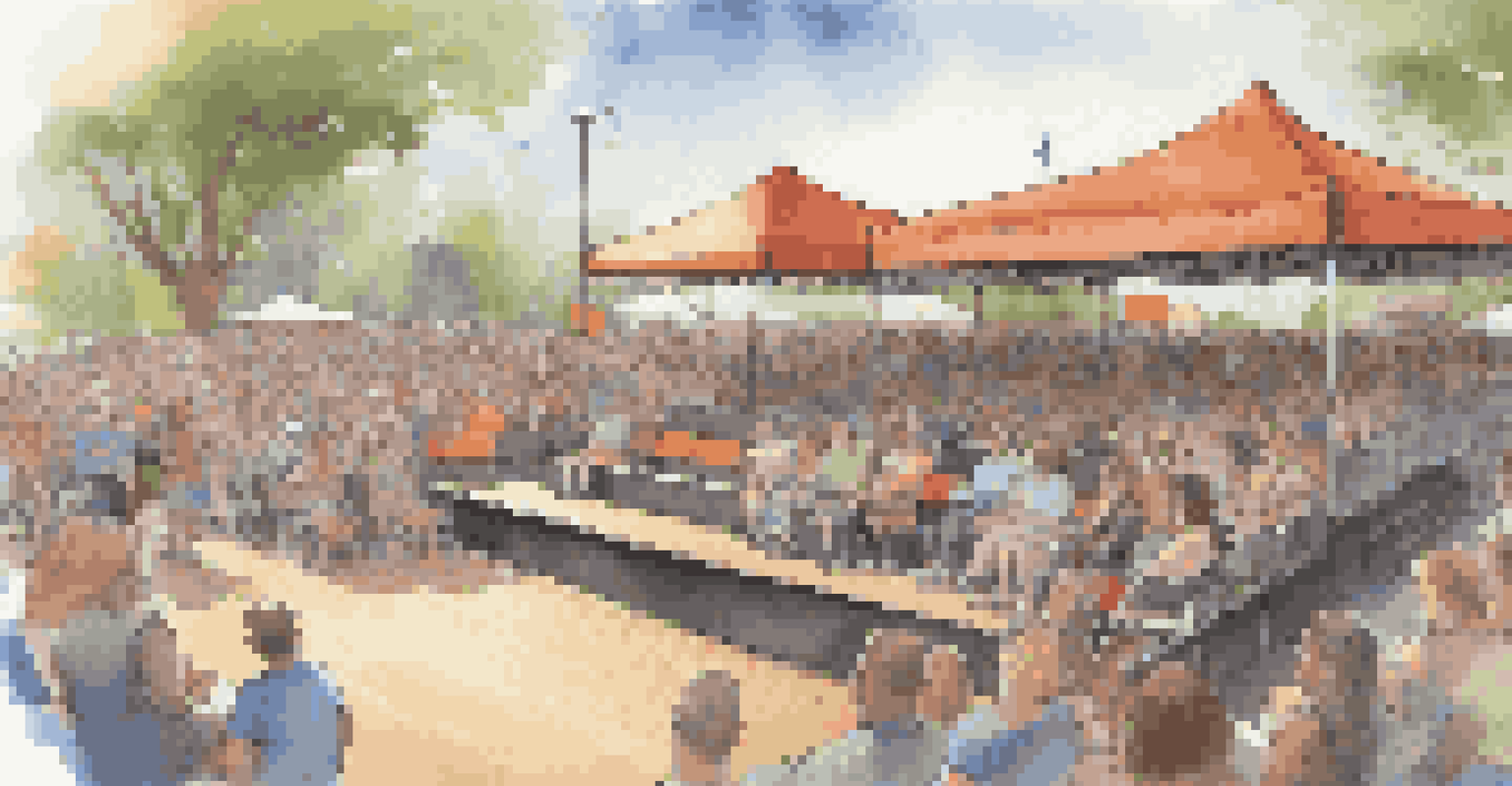The Importance of Accessibility in Music Festivals Today

Accessibility: A Fundamental Right at Music Festivals
Accessibility is not just a nice-to-have; it's a fundamental right that everyone deserves, especially at music festivals. When we think about music events, we often envision crowds dancing and enjoying performances, but this experience should be inclusive for all. It’s essential to recognize that people with disabilities have the same right to enjoy these events as anyone else.
Accessibility is not a privilege, it is a right.
Consider this: a music festival could have the best lineup in the world, but if it's not accessible, it limits the audience. Imagine a person in a wheelchair arriving at a festival where there are no ramps or designated seating areas. This scenario highlights the need for thoughtful planning and design that accommodates everyone, enabling all festival-goers to enjoy the music equally.
Creating accessible spaces enhances the overall festival experience, not just for those with disabilities but for everyone. When accessibility is prioritized, it fosters an environment of inclusivity, encouraging diverse crowds to come together and celebrate music without barriers.
The Legal Framework Supporting Accessibility
In many countries, laws require public events to be accessible to individuals with disabilities. For example, in the United States, the Americans with Disabilities Act (ADA) mandates that venues, including music festivals, must provide accessible facilities. This legal framework ensures that festival organizers take necessary steps to accommodate all attendees, promoting equality in entertainment access.

However, merely meeting legal requirements is not enough. Festivals should aim to exceed these minimum standards, creating an environment that is genuinely welcoming. This means not just providing ramps or accessible toilets but also considering aspects like audio descriptions for the visually impaired or quiet spaces for those with sensory sensitivities.
Accessibility is a fundamental right
Everyone deserves the opportunity to enjoy music festivals, regardless of their abilities.
When festivals proactively embrace accessibility, they not only comply with the law but also demonstrate a commitment to social responsibility. This can enhance their reputation and brand loyalty among audiences who appreciate their inclusiveness.
Benefits of Inclusivity for Music Festivals
Inclusivity in music festivals brings numerous benefits, both socially and economically. By ensuring that everyone can participate, festivals can attract a larger audience. This not only increases ticket sales but also broadens the festival's appeal, making it a more vibrant and diverse event.
Inclusion is not a matter of political correctness. It is the key to growth.
Moreover, a diverse audience means a richer cultural experience for all attendees. Different perspectives and backgrounds contribute to a more dynamic atmosphere, creating memories that resonate beyond the festival grounds. When everyone is included, the collective energy and enjoyment multiply, making the event truly special.
Inclusivity also fosters a sense of community among attendees, as they share in the collective experience of music. By promoting accessibility, festivals can create spaces where friendships blossom and connections are made, reinforcing the power of music to unite people.
Real-Life Examples of Accessible Festivals
Several music festivals have set the bar high with their accessibility initiatives. For instance, the Glastonbury Festival in the UK has made significant strides by providing accessible viewing platforms, sign language interpreters, and specialized services for attendees with disabilities. Their efforts serve as a model for other festivals looking to enhance their inclusivity.
Similarly, Coachella has made a commitment to accessibility by offering accessible camping options, as well as dedicated staff to assist attendees with disabilities. These initiatives not only improve the experience for those with specific needs but also demonstrate that accessibility can be seamlessly integrated into the festival's overall design.
Legal frameworks support inclusivity
Laws like the ADA ensure that music festivals provide necessary accommodations for individuals with disabilities.
These examples illustrate that when festivals prioritize accessibility, they pave the way for others to follow. By showcasing best practices, they inspire a movement towards more inclusive events across the music industry.
Challenges Faced in Implementing Accessibility
Despite the clear benefits of accessibility, many festivals still face challenges in implementing these initiatives. Budget constraints can be a significant barrier, as organizers may prioritize other aspects of the event over accessibility features. However, it’s important to view accessibility as an investment rather than a cost.
Additionally, some festival organizers may lack awareness or knowledge about how to create accessible environments. This can lead to misunderstandings about what constitutes adequate accessibility, resulting in inadequate provisions. Continuous education and training are essential for event planners to recognize and address these gaps effectively.
Lastly, logistical challenges such as venue selection and crowd management can complicate accessibility efforts. However, with thoughtful planning and collaboration with accessibility experts, these challenges can be overcome, ensuring that everyone can enjoy the festival experience.
How Attendees Can Advocate for Accessibility
Attendees play a crucial role in advocating for accessibility at music festivals. By voicing their needs and sharing their experiences, they can help raise awareness about the importance of inclusive spaces. This advocacy can take many forms, from providing feedback to organizers to sharing their experiences on social media.
Moreover, attendees can support festivals that prioritize accessibility by choosing to attend those events. By voting with their feet, they send a clear message to organizers that inclusivity matters. This consumer behavior can influence festival organizers to focus more on accessibility in future planning.
Inclusivity benefits everyone
Creating accessible environments attracts diverse audiences, enriching the festival experience for all attendees.
Lastly, forming community groups or networks among festival-goers can amplify the call for accessibility. These groups can collaborate on initiatives, share resources, and create a collective voice that encourages festivals to adopt more inclusive practices.
The Future of Accessibility in Music Festivals
The future of music festivals is increasingly leaning towards inclusivity and accessibility. As awareness grows and more voices advocate for change, we can expect to see more festivals implementing innovative accessibility features. This shift is not only beneficial for attendees with disabilities but also enriches the overall festival experience for everyone involved.
Technology will also play a significant role in enhancing accessibility at festivals. Innovations like mobile apps that provide real-time information on accessible facilities or virtual reality experiences for those unable to attend in person can transform how we think about accessibility in the music scene.

Ultimately, the goal is to create a festival landscape where everyone can enjoy music without barriers. As more festivals embrace this vision, we can look forward to a future where inclusivity is the norm, making live music an experience that everyone can share and enjoy.